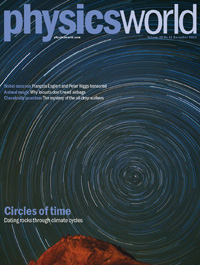Tag archives: biophysics
Partying bacterial biofilms throw out streamers
By Tushna Commissariat at the APS March Meeting in Denver
The word “streamers” doesn’t normally bring bacteria to mind, but it’s all the rage with biophysicists studying the mechanics of bacterial biofilms that grow where there is fluid flowing. A biofilm is any group of microorganisms where cells stick to each other on a surface – either a living or non-living surface will do. A rather simple example of this is the slimy film that develops over our teeth each night.
Biophysicist Knut Drescher from Princeton University gave a fascinating talk at the APS March Meeting on Monday about his research into why biofilms that grow specifically in the presence of a flowing fluid – such as in channels in soil, filtration systems, as well as medical devices such as stents or urinary catheters – are rapidly clogged, causing a variety of problems and infections. Biofilms in such a case form 3D thread-like “streamers” that are responsible for the rapid clogging. It was initially thought that these streamers formed along the walls of the original film and then expanded inwards, but Drescher and colleagues found that it was actually the other way around – the fishing-line-like streamers grew from the middle and rapidly extended outwards, clogging a channel within minutes.
View all posts by this author | View this author's profile
‘Mile-high’ physics

By Tushna Commissariat at the APS March Meeting in Denver
The city of Denver, Colorado has been invaded…or so I am sure the locals will feel over the next few days, as more than 9000 physicists from all over the world have arrived to take part in the APS March Meeting. I have been here in the “Mile-high city” of Denver – so nicknamed thanks to its official elevation that is exactly one mile or 5280 feet above sea level – since Sunday morning, and physics is the talk of the town as everyone descends upon the Colorado Convention Center (pictured above).
As always, there is a wide variety of interesting talks, sessions and press conferences over the next few days and I would have to clone myself multiple times to get around to all of them. Talking about cloning, though – I have just been to my first session, where Stanford researcher Patrick Hayden was taking about quantum information and asking whether or not it could be cloned in space–time. I will be speaking with Hayden later in the day, so watch this space if you would like to know more.
Waiter, there’s a bug in my cocktail!
By Hamish Johnston
Just in time for Christmas, researchers at the Massachusetts Institute of Technology (MIT) have unveiled the ultimate “cocktail accessory”. It’s an edible self-propelled boat that whizzes around on the surface of an alcoholic drink.
The November 2013 issue of Physics World is now out
By Matin Durrani

Well, despite all the excitement of last month’s special 25th-anniversary issue of Physics World, there’s been no let-up for us – we’ve been busy beavering away on the next issue of your favourite physics magazine, which is now ready for you to read in print, via our apps or online.
If you’re a member of the Institute of Physics (IOP), you can access the entire new issue free via the digital version of the magazine or by downloading the Physics World app onto your iPhone or iPad or Android device, available from the App Store and Google Play, respectively.
Our cover story this month is about a strange series of experiments, carried out by Yves Couder and Emmanuel Fort at Paris Diderot University, examining the behaviour of oil droplets vibrating on the surface of an oil bath. The droplets are classical in nature but also seem to show much of what would be expected of a quantum system, including interference patterns. So is this coincidence or not? Jon Cartwright investigates.
Physics of cancer: free PDF download of the July 2013 issue

Physics World July 2013 special issue on the physics of cancer.
By Matin Durrani
Medical physicists have made – and continue to make – many valuable contributions to the treatment, diagnosis and imaging of cancer using X-rays, magnetic fields, protons and other subatomic particles. But some physicists are trying to tackle cancer through a very different approach. Rather than seeing cancer purely in terms of genetic mutations, these researchers are instead examining the physical parameters that control how cancer cells grow, evolve and spread around the body.
Find out more by downloading your free PDF copy of the July 2013 special issue of Physics World on the “physics of cancer”.
View all posts by this author | View this author's profile
Bright spots in the Euro-gloom

European Parliament in Brussels. (iStockphoto/Franky De Meyer)
By Margaret Harris in Brussels
For an event built around celebrating Europe’s best scientific spin-out companies, the Academic Enterprise Awards got off to a downbeat start. “Europe is lacking growth, lacking jobs and lacking entrepreneurial appetite,” declared Joanna Drake, director of small and medium-sized enterprises (SMEs) within the European Commission. Such enterprises “have a difficult life, and this is getting worse, not improving” agreed the event’s second speaker, MEP Maria Da Graça Carvalho of Portugal. Then there was Roland Siegwart, vice-president for research and corporate relations at ETH Zurich. In a splendid bit of understatement, he lamented the fact that many bright scientists at his university “have a somewhat not awake entrepreneurial spirit”.
View all posts by this author | View this author's profile
Five of the best
By Margaret Harris at the APS March Meeting in Baltimore
With so many sessions taking place at the APS March Meeting, finding time to write about them is almost impossible. However, now that I’m waiting for my flight from Baltimore back to the UK, I’ve got all the time in the world – so here’s my list of five conference highlights.
Flowers and bees communicate using electric fields
By Hamish Johnston

Half of each of these flowers has been treated with a charged powder.
(Courtesy: Dominic Clarke and Daniel Robert)
Spring will soon be upon many of us – and for me, nothing evokes the spirit of the season more than a bee buzzing from flower to flower on a warm, sunny afternoon. But I never would have guessed that a bee takes a measure of a flower’s electrical field before it alights.
View all posts by this author | View this author's profile